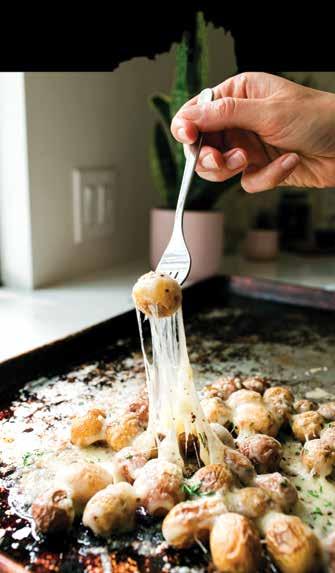






“Winter is the time for comfort, for good food and warmth, for the touch of a friendly hand and for a talk beside the fire: it is the time for home.” —EDITH SITWELL 6 NOTABLE EDIBLES by Emma Waldinger, Hannah Wente and Michael Brandt
RECIPE INDEX
NOURISH For the Love of Liver by Laura Poe Mathes
LOCAL MAKERS Craftsmanship to Feed the Soul by Anna Thomas Bates
HOLIDAY SHOPPING GUIDE
DRINK LOCAL Wisconsin Flavor at State Line Distillery by Jessica Jones 26 FOODWAYS From Our Grandmothers’ Hands by Christy McKenzie
AN OYSTER PRIMER by Emily McCluhan

COOK AT HOME Let Vegetables Steal the Show by Lauren Rudersdorf
FRESH COAST FISH by Hannah Wente
Above: Oyster celebration at Sardine.
Photo by Tracy Harris.
Cover: Rosettes fresh from the oven. Photo by Sunny Frantz.
WE ARE WHAT WE EAT It’s Time To Make Food Decisions With the Climate Crisis in Mind by Twilight Greenaway
BITE
Anna moved to Wisconsin 21 years ago, and after shopping at the Dane County Farmers’ Market and wandering through the Driftless Area, she hasn’t looked back. Co-owner of Landmark Creamery in Paoli, if she isn’t tasting/selling cheese, you’ll find her writing about food, reading a good book, swimming or hiking with her two boys.
Michael’s observations and commentaries have appeared across a spectrum of Midwest news and special interest publications. He is privileged to share a ridgetop in Arena with his wife, Janet, and their large hound.

Sunny is an editorial and commercial photographer with a studio on the west side of Madison where she lives with her husband, their two kids and a tiny dog. She specializes in food and product photography and loves the opportunity it gives her to connect with the many wonderful businesses and entrepreneurs in Madison.
Tracy is a graphic designer and photographer from Madison. A polymath at heart, she dabbles in various arenas of makery including cooking and baking, sewing and knitting, painting and collage, and has a soft spot in her heart for film photography. When she’s not busy making things, she enjoys travel, good food and drinks, gardening and live music.
Jessica is the Brewer and co-owner of Giant Jones Brewing Company, an independent, women-owned, certified organic craft brewery in Madison. She is a Grand Master Beer Judge through the Beer Judge Certification Program (BJCP) and an Advanced Cicerone®. Jessica loves Barleywine and providing extremely indepth answers to what you believed was a simple question.

Emily is a Madison-based writer, runner, volunteer and dog mom. Her contributions to regional publications in Michigan, Montana and Wisconsin over the last 20 years provide an outlet for her insatiable curiosity and passion for telling the stories that open our eyes and connect to our everyday lives.
Christy is the owner of Pasture and Plenty – a specialty market and deli, demonstration kitchen, and meal kit pick-up and delivery service. P&P gives the community access to healthy, locallysourced meals and foods that make eating well and eating local easier every day. She works to create and connect community around issues of food equity, access and agency. She is an ownerpartner in Edible Madison and a sometimes writer.
Nicole is a graphic designer, photographer and artist from Madison. She enjoys being a cat mom, going on long walks and listening to podcasts, watercolor painting, and spending time with friends and family. She is also a co-founder of New Fashioned Sobriety, an alcohol-free community based in Madison which hosts monthly meetups and events.
MANAGING EDITOR
Lauren Langtim
PUBLISHERS
Christy McKenzie
Cricket Redman

BUSINESS DIRECTOR Christy McKenzie
CREATIVE DIRECTOR Cricket Redman
SALES DIRECTOR Lauren Rudersdorf

LAYOUT Nicole Peaslee
COPY EDITOR Andrea Debbink
CULINARY ADVISOR Christy McKenzie

SOCIAL & DIGITAL PRODUCER Lauren Rudersdorf
ADVERTISING & SPONSORSHIPS


Lauren Rudersdorf laurenr@ediblemadison.com

DRIFTLESS REGIONAL SALES MANAGER Kristen Wagner kristen@ediblemadison.com
CONTACT US
Edible Madison 4313 Somerset Lane Madison, WI 53711 hello@ediblemadison.com
Subscriptions are available beginning at $35 annually. Learn more at ediblemadison.com/subscribe
We want to hear your comments and ideas. To write to the editor, use the mailing address above or email hello@ediblemadison.com.
Edible Madison is published quarterly by Forager Publishing, LLC. All rights reserved. No part of this publication may be used without written permission by the publisher. ©2021.
Every effort is made to avoid errors, misspellings and omissions. If, however, an error comes to your attention, please accept our sincere apologies and notify us. Thank you.
VISIT US ONLINE AT EDIBLE MADISON.COM


Laura is a registered dietician in private practice, focused on healing with real foods and herbs. She loves to spread knowledge and enthusiasm for great food, and teach traditional cooking and fermentation classes around the region. Originally from Missouri, Laura lives in Viroqua and now understands why cheese curds are a thing. She also loves to canoe, drink coffee and watch stand-up comedy.
Lauren owns and operates Raleigh’s Hillside Farm outside of Evansville with her husband Kyle. Together they manage ten acres for their growing CSA and hemp businesses. When she’s not out in the fields, Lauren shares seasonal recipes on her blog The Leek & The Carrot

Emma (she/her) is a writer, grower and maker based in Madison. She cherishes warm summer memories spent at her grandparents’ hobby farm and harvesting from her family’s backyard vegetable garden. These experiences have been the catalyst for her fascination with the intersections between art, ecology, agriculture and good food. When she’s not dreaming of the perfect cake, Emma helps to produce community events at Pasture and Plenty.


Hannah grew up as a 4-H kid on the shores of Lake Michigan. She is a freelance writer and graphic designer based in Madison. In her previous role as communications director for REAP Food Group, she helped launch the new statewide Farm Fresh Atlas project and supported farm-to-school and farm-to-business efforts. When she’s not gardening, cooking or baking, you can find her playing ultimate frisbee or paddling the nearest lake.
This issue has been a fun one to put together. Like a good holiday smorgasbord, it has a little bit of everything. If you’re an adventurous eater, this issue’s for you, because we’ve managed to feature both oysters and liver! We’ve got a long winter ahead of us. What better way to pass the time than to expand your palate a little bit?
We did pause and question whether oysters were the right subject matter for Edible Madison to cover, seeing as how we live for local food and last we checked there were no oysters to be found in Lake Mendota. But eating local doesn’t have to be an all-ornothing proposition. There is value in supporting local restaurants, especially ones like Sardine, who have a stellar reputation for being authentically farm-to-table, and who also offer out-of-town delicacies like oysters, because they’re passionate about good food.
The Edible team is cooking up a number of winter events that we’re very excited about. On November 17th, we’ll celebrate the release of this issue with a cheese tasting and pairing workshop with Anna Thomas Bates of Landmark Creamery.
On December 1st, we’ll host a virtual screening of The Ants and the Grasshopper, a powerful award-winning documentary that follows Anita Chitaya, a Malawian climate change activist, as she travels across the U.S. to talk with climate-skeptic farmers and community leaders.

We’re also putting together a cheese board class for later in the winter, featuring local products and expert instruction on how to artfully arrange boards that are as visually stunning as they are fun to eat. More details to come—be sure to sign up for our email newsletter and follow us on social media to stay up to date!
We hope you enjoy this issue and find something worth revisiting in it throughout the winter, from that giddy first snow phase to the doldrums of February. As always, we want to send a great big thank you to everyone who contributed to this issue. Cheers!
Let’s dig in!
 Lauren Langtim Managing Editor
Lauren Langtim Managing Editor
P.S. As always, we welcome your thoughts and feedback. Drop us a line at hello@ediblemadison.com.

"I am blown away. You have found a hero of such grace and intelligence and power... e lm is obviousy not about agriculture in the way I expected to be — it’s much bigger than that. We get to observe history. ”
AUTHOR
Muloma Heritage Center is a non-profit organization that is an e destination exploring the African Atlantic influences in American culture, and its contribution to American cuisines that bridges the gap between the past, presen t and future, and creates a legacy for future generations. Learn more at muloma.com.



According to Liz Fitzsimmons from Dairy Farmers of Wisconsin, “Nothing says the holidays like port wine spread.” Pine River packs together Wisconsin Grade A aged cheddar and sweet, fruity port wine in a spreadable topping. Pair it with a big plate of whole wheat crackers (you’ll want to eat the whole tub), toasted walnuts, dry hard cheeses and local cured meats.
^ Uplands Rush Creek Reserve A coveted Wisconsin winter specialty, Uplands Cheese’s Rush Creek Reserve embodies the local landscape. Produced only in the fall, as Uplands’ cows are weaned from summer pasture to winter’s dry hay, Rush Creek is a rich cheese with a “savory custard” texture and a “subtle woodsy flavor.” Wrapped in spruce bark, this cheese is the perfect centerpiece for a special meal—get your hands on it before it sells out!
Carr Valley Cranberry Chipotle Cheddar This award-winning cheese balances tart cranberries with smoky chipotle in a smooth white cheddar. Celebrate Wisconsin’s state fruit, and an iconic winter flavor, in this fun twist on a classic cheese. Make a spread of Carr Valley’s Cranberry Chipotle Cheddar by plating it with dark chocolate, orange slices and root vegetable chips.
by Emma WaldingerCut the rich flavor of fresh goat cheese with a sweet and spicy cranberry cinnamon combination. Roth Cheese’s Cranberry Cinnamon Chèvre is a new favorite that creates kinship between divergent flavors. Pair it with spiced nuts, cured meats and hearty seasonal beverages like ciders and barrel-aged beers.
^ Landmark Creamery Fondue A New Year’s staple and the essence of any fun winter gathering, come together around Landmark Creamery’s Sheep Milk Fondue. This cheese blends Landmark Creamery’s Anabasque and Pipit cheeses for notes of fruit, funk and nuttiness. Assemble a spread of your favorite fondue toppings and make a party of it, or mix into macaroni and cheese, pizza, scalloped potatoes or grilled cheese.

Holland’s Family Cheese’s signature Foenegreek Gouda marries the freshest Wisconsin cow’s milk with authentic Dutch craftsmanship. Marieke Penterman brings her award-winning talent for cheesemaking to this syrupy and nutty cheese, using herbs, seeds and spices gathered from the Netherlands and milk fresh from her family farm’s raw cow’s milk. The expert cheesemongers at Fromagination on the square recommend pairing it with Potter’s Winter Wheat Crackers, maple syrup, toasted almonds, dark rum or amber beer.


Candinas has been selling its signature boxes of chocolates on the Capitol Square since 1994. Founder Markus Candinas learned the craft as an apprentice in Switzerland. Favorites like champagne, ginger and hazelnut truffles ship throughout the U.S. in days.


CocoVaa Chocolatier founder, Syovata Edari, is a criminal defense lawyer turned international award-winning chocolatier. While operating a small business has its challenges, Edari says that ”being a micro business has allowed me to build direct relationships with the ingredient providers in our value chain.” She takes a trip to Sassy Cow Creamery in Sun Prairie each week to get her cream and gets her 83%-fat European butter from Grasslands Dairy in Greenwood, owned by the Wüthruch family. She often incorporates J. Henry & Sons bourbon in her recipes and sources other spirits from Yahara Bay Distillery. She also sources herbs from local farmers. CocoVaa Chocolatier is located at 1815 East Washington in Madison.
^ Gail Ambrosius left behind a career in cartography to become a full-time chocolatier and we are so glad she did. Her travels to South American cacao farms inspire chocolate flavors and techniques that preserve and honor the star ingredient. Her new location on Atwood Avenue (across from her former location) showcases ancient chocolate-making artifacts.
^ Madison Chocolate Company on Monroe Street is a treasure trove of gluten-free treats and innovative truffles. The London Chew features housemade caramel between gluten-free graham crackers and toasted coconut white chocolate curry. The Wall of Chocolates features international holiday delights as well as the best pure chocolate bars from countries like Vietnam and Brazil.
Roots Chocolates owner and fourth-generation farmer Lisa Nelson crafts single-origin chocolates from fruits and herbs of the farmscape surrounding Wisconsin Dells. Award-winning chocolates include her chocolate mint basil and quince truffles. Find Roots at the Dane County Farmers’ Market.
^ WM. Chocolate is Madison’s go-to for dark chocolate bar lovers. Founder William Marx is committed to sourcing organic, whole-food ingredients from as close to Madison as possible. Find Dark + Salt with sea salt crystals harvested in the U.S. and Extra Dark bars at retailers like Good Day Shop.
In the midst of the farms and wooded hills which define the Wisconsin River Valley, a celebration is taking shape. Emerging through the autumnal twilight, guests are drawn to this particular half-acre not just by the promise of good food, good wine and good music, but to honor the extraordinary couple who have imbued it with a magic all its own.
The Shoppe at Herbs, Spices & More is a familiar landmark to those traveling Highway 14, west of Madison. Yet the charming, unassuming red-and-white storefront offers barely a hint of its remarkable story.

When Bob and Kate McQuade acquired the former gift store in 1989, the plan was simple. They would cultivate a variety of herbs which Bob would wholesale to area restaurants. It was a market he knew well. Having first apprenticed at age 15, Bob’s career followed the sporadic, often manic path familiar to all successful chefs. In his native environment, i.e., greater New York, competition was fierce. Yet each new opportunity advanced not only his culinary skills but his overall knowledge of the restaurant business.

The McQuades came to the Midwest to raise a family. Bob continued through a long succession of prominent positions,
including Executive Chef at the iconic Spring Green Restaurant (today’s Riverview Terrace). Originally, The Shoppe was intended to be a retirement project. Once open the business was soon running at full throttle. Each week, Bob was delivering not only herbs, but spices, mushrooms and even edible flowers to dozens of Madison restaurants. It wasn’t until 2000 that he decided to retire “for good.”
Three years later, the McQuades reopened The Shoppe as the retail operation it is today. Fresh bread and other baked goods became standard. The offer of coffee to neighbors who came to chat morphed into a Sunday morning institution known as “Church of the Sweet Roll.”
Dozens of handmade pizzas are made in the outdoor brick oven every Tuesday during the warmer months. Once again, there is laughter and song under strings of tiny lights. Having recently marked his 90th birthday, “Papa Bob” is still contemplating retirement. Closing the retail business, for sure. Maybe serving only the occasional formal dinner. For just a few patrons. And of course, it would be ungracious to refuse any request to serve as a “guest” chef…
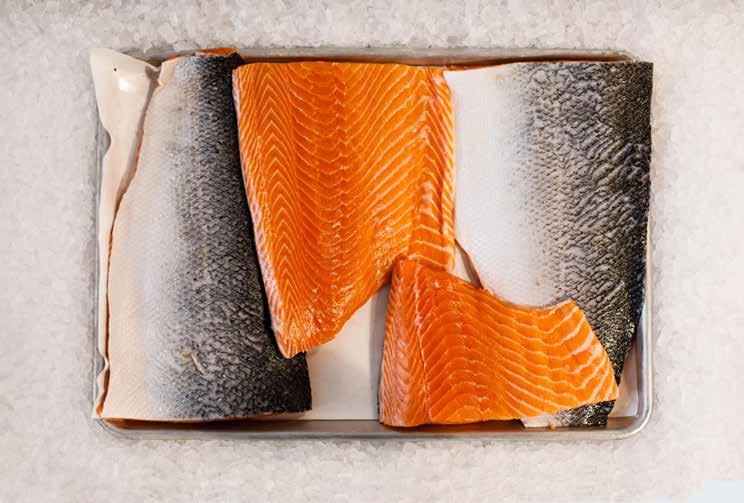







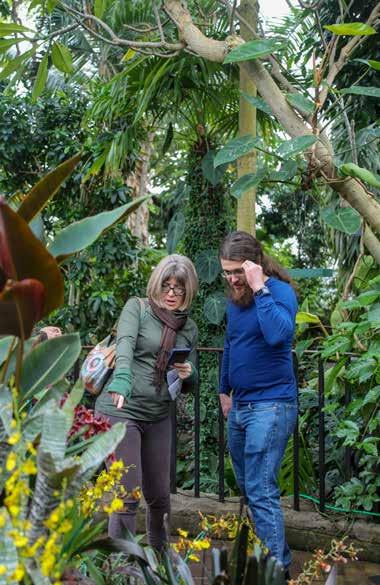
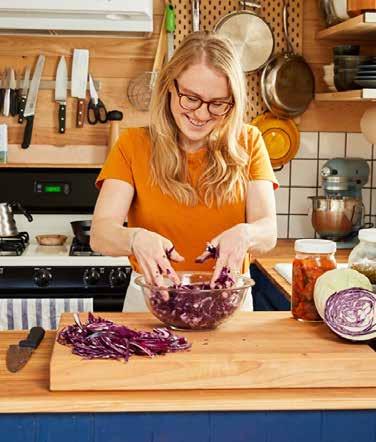 There’s plenty growing at Olbrich this winter, whether you’re taking a class or warming up while exploring the Bolz Conservatory. Check out our online and in-person offerings at
There’s plenty growing at Olbrich this winter, whether you’re taking a class or warming up while exploring the Bolz Conservatory. Check out our online and in-person offerings at
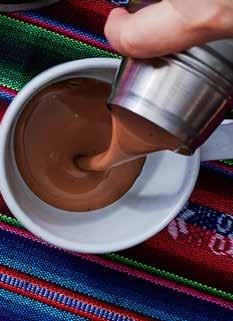



For all my meat-eating folks out there, it’s time to talk about liver. While the idea of eating liver may conjure up images of your grandma serving liver and onions as you plug your nose, this is actually an important and nourishing food. Until the last couple decades, liver was a staple in the human diet for millennia and for good reason: liver is one of the most nutrient-dense foods available to us.
Unfortunately, tastes changed a few generations back thanks to the advent of processed foods, making hyperpalatable foods easily accessible and leading many away from cooking in general. More recently, ethical and environmental issues with conventional agriculture have soured many people’s views on eating animal products at all. We’ve lost the tradition of cooking with the whole animal, steering us away from eating liver and other organ meats. Sadly, this is the wrong direction to go in if we want to nourish ourselves and the land. Eating nose-to-tail means using as many parts of the animal as possible and not just the muscle meats (think steak, roasts, etc.), and this way of cooking and eating needs to make a comeback.
The odd bits, also called offal or organ meats, are just as nutritious as, in some cases more so than, the rest of the animal. As a dietitian, I find that many people lack the vital nutrients that are so abundant in organ meats like liver, and instead consume supplements or less bioavailable (as in, less well absorbed and utilized by the body) plant foods in attempts to bring balance to their health. Eating more traditional foods may be a better first step than taking more supplements.
While bone broth is all the rage right now (and rightly so, as it is an incredible, healing food), other parts like liver should be included in the diet as well, along with heart, kidney, tripe, tongue, skin and fat. Liver has been an essential part of indigenous diets all over the world, especially for children, the elderly, ill, and pregnant and nursing women, as it was prized for its healing properties and extraordinary nutrition. Liver truly cannot be matched by most other animal foods and any plant foods in terms of nutritional value, hence its earned title of superfood. Because of the incredible nutrition found in liver, it should be included and revered in the diet.
With its unique composition and balance of nutrients, I think of liver as a multivitamin/mineral in food form. While plant foods are important sources of fiber, phytochemicals
and other nutrients, emphasizing specific animal foods is a must when it comes to creating a nutrient-dense diet.
What exactly does this superfood offer? It is pretty incredible: liver is the best source of bioavailable vitamin A (retinol) and is packed with vitamins B12, D and K2, folate, choline, niacin and riboflavin. It is rich in minerals, including zinc, iron, phosphorus and copper. Liver also contains potassium and vitamin C, which are commonly thought to be in plant foods only. Organ meats like liver provide amino acids like glycine, which helps to balance the amino acid methionine found primarily in the muscle meats, which is important for maintaining health when consuming animal foods.
To get the maximum benefit from liver in your diet, you only need to eat a few ounces once or twice per week, which can be easy to do if you know how to cook with it. Eating liver can take some getting used to and it’s not my favorite flavor, but it is my favorite food nutritionally speaking, so finding ways to get it in is important. Liver is commonly consumed as spreads like pâté and mousse, as well as in the Wisconsin favorite, braunschweiger, but these may not be staples in most people’s diets. Of course, there is always liver and onions, but this is not necessarily a crowd-pleaser these days. My solution to this less-palatable but essential food, and our favorite way to eat it at my house, is to grind the liver and mix it into ground beef or pork, as a way to disguise it in many different dishes. I typically use a ratio of about ¼ pound of liver to 1 pound of ground meat; this mixture can be used for tacos, burgers, chili, meatballs, sloppy joes, laab (a Thai dish) or any dish that features ground meat, such as meatloaf.
You can use the liver from just about any animal, such as cows, pigs, chickens, ducks or lamb, and I encourage you to choose pasture-raised sources when you can. Liver can be tricky to find at most grocery stores, so it is best obtained by talking directly to a farmer in your area, such as at a farmers market or through online channels that connect you to area farmers. Some stores with a local-food focus may carry organ meats as well. Use a local, trusted source of meat when purchasing liver and other organ meats to ensure you are getting a highquality, nutritious product. Nose-to-tail eating that includes superfoods like liver uses the whole animal, which reduces food waste, supports farmers, protects the planet, honors the life of the animal used for our food, and nourishes eaters.
Meatloaf may not be the hippest dish, but it is a great wintertime comfort food to nourish the whole family. It is one of my favorite ways to get a little liver in and a perfect introduction to disguising liver with ground meat. When chopping liver to add to recipes, try to grind it in a food processor or meat grinder when it is still half-frozen to help create the right texture and prevent it from becoming a puree. Feel free to use ¼ cup organic ketchup as the topping in lieu of the homemade sauce below.
Serves 4-6
Prep time: 20 minutes
Cook time: 1 hour 15 minutes
For the meatloaf:
1 tablespoon unflavored gelatin powder
2 tablespoons whole milk or nondairy milk
1 pound ground beef (80/20)
½ pound ground pork
¼ pound beef or chicken liver, ground
1 cup diced onions
3-4 cloves garlic, minced
2 eggs, beaten
2 teaspoons fresh rosemary, finely chopped
½ cup chopped fresh parsley
½ teaspoon sea salt
¼ teaspoon ground black pepper
1 cup sourdough breadcrumbs (store bought or homemade from day-old sourdough bread); you can substitute 1 cup gluten-free breadcrumbs or ½ cup uncooked oats or almond flour for glutenfree or grain-free variations)
½ cup grated Parmesan cheese
For the sauce:
¼ cup tomato paste
2 tablespoons water
1 tablespoon maple syrup
1 teaspoon Dijon mustard
½ tablespoon apple cider vinegar
Pinch of salt and pepper
1. Preheat the oven to 350 degrees F, and line a loaf pan with parchment paper.
2. In a small bowl, whisk the gelatin into the milk to dissolve, then set aside.
3. In a large mixing bowl, combine the beef, pork, liver, onions, garlic, eggs, parsley, rosemary, salt, pepper, breadcrumbs, Parmesan and dissolved gelatin. Stir with a spoon or by hand to create a uniform mixture, being careful not to overmix.
4. Transfer the meat mixture into the prepared loaf pan, gently pressing to create an even layer.
5. Cover with foil or parchment and bake for 45 minutes.
6. While the meatloaf bakes, prepare the sauce by whisking the sauce ingredients together until well combined.
7. After 45 minutes, carefully remove the pan and spread the sauce over the top of the meatloaf. Leave the pan uncovered and bake for 15-20 minutes, until a meat thermometer reads at least 165 degrees F.
8. Remove the meatloaf from the oven and let it sit for 15-20 minutes before slicing and serving.

Local farmers pick tomatoes at peak ripeness, delivering them to markets and restaurants in pristine condition. Chefs use their unique perspective to highlight homegrown vegetables and livestock raised with care. Brewers, cheesemakers and distillers craft distinctive products in small batches using traditional methods. But local food produced with care isn’t the only way a community is nourished. Local artisans and makers put the same thought and care into creating items that feed the soul with their beauty and craftsmanship. Here are four local businesses creating goods that enhance and impact how food is enjoyed every day.
FeLion Studios americanskillet.com felionstudios.com
Alisa Toninato of FeLion Studios and American Skillet Company is an artist who expresses herself with 2000-degree molten iron. She studied at Milwaukee Institute of Art and Design, working with metal, sculpture and cookware. After an artist’s residency in Norway, she was inspired to create her first cast-iron skillet in the shape of Wisconsin. This expanded into a desire to create the entire map of the United States out of cast- iron pans, and this launched her career and subsequent two companies. After showing at ArtPrize in Grand Rapids in 2011, Martha Stewart featured Alisa and her cast-iron map on her last show, and FeLion Studios was one of the first companies to be honored with Martha Stewart’s American Made Awards.
This publicity created a demand for Alisa’s skillets and the American Skillet Company was born. The company uses multiple foundries to make a core set of state-shaped skillets manufactured in larger numbers for the public. Each pan is finished and shipped from Alisa’s studio, which was recently relocated to a larger space in Waunakee. Alisa runs the American Skillet Company, but she also stokes her passion with FeLion Studios, a company that creates art, stages community events and creates custom cast-iron pieces for restaurants and more.
Settling into her new, larger space, Alisa wants to expand beyond iron casting to non-ferrous founding classes (using materials like bronze aluminum), offering more classes, artists’ residencies, and she dreams of collaborating with local high schools to teach founding. “It’s engineering and art all in one, and it’s a skill that teaches kids how things are made. Kids need to know this stuff.”

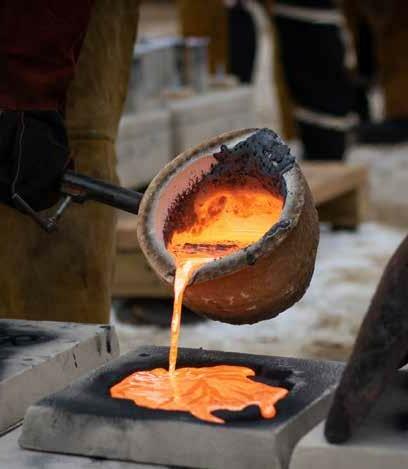




Isaiah Schroeder was always an artist, making furniture, sculpture and jewelry. While working at Richard Judd Furniture and Zazen Gallery in Paoli, a customer came in looking for custom knife handles. Isaiah was intrigued and began exploring the craft. Through YouTube videos and trial-and-error, he taught himself and sold his first knife in 2015.
People may imagine a knifemaker spends all day forging, but Isaiah says this is “only about one-sixth of the process, but it is the most fun. It’s a free-form art, like making something out of clay. I have a library of templates, but I let the forging dictate how the knife will be. Each one is an individual and unique, even if it is one of my regular offerings.”
He ships knives worldwide, about half to home cooks and half to professionals. He guesses he makes about 150 knives per year. A simple knife takes about 10 hours to make, while a more complicated Damascus style can be closer to 40 hours.

What makes a custom blade different from something you’d find at an upscale kitchen store?
“We use higher quality materials, heat-treat the knife to a higher hardness, and spend more time on the grind. We grind it thinner and tweak it so it’s as high-performance as it can be. And we of course focus on aesthetics. A lot of the knives by large brands are made by machine.” Isaiah’s most popular knife is his 180-mm Damascus Gyutu, a small, Japanese-style chef’s knife. This is the one he personally uses most often in his own kitchen. Another regular style in his online shop is a small cheese cleaver with a Wisconsin silhouette cut from the middle (which handily doubles as a bottle opener). His knives sell quickly, but those available for purchase are on his website, schroederknifeworks.com.
He also offers a “Forge a Chef’s Knife” class for four people at a time. Subscribe to his newsletter to see announcements on classes and when knives are available.
Top: each knife is its own functional piece of art. Bottom: Forging a knife.

Homesteaders Bethany Emond, Danielle Dockery and Brandi Bonde raise animals, including sheep, goats and alpacas. Bethany was a vegetarian for 25 years. “I needed to start eating meat for health reasons, so I began raising my own animals with respect, care and thoughtfulness. When an animal is commercially butchered, the meat is sold, and the undesirable leftovers are typically tossed. When it comes to the final stage, I don’t want to throw any part of them away. I use the bones, fat, skin—every part I can.” This is her way of honoring the animal that nourishes her family.

They each found a lack of services when it came to treating hides. Bethany tried sending hides to conventional tanneries. But later as she lounged against fluffy sheep fiber on a favorite reading chair, her mouth and nose filled with the smell of harsh metal. Brandi attempted to tan hides herself, using the traditional method of brain-tanning (using the natural chemicals in an animal’s brain to preserve hide) with some success, but there still was a lot to learn.


Through extensive research, and a lot of trial-and-error, they devised a way to tan hides without using harsh chemicals like bactericides, insecticides, bleach and heavy metals. Their business has only been open for one year, and they are already looking for more space, poised to double their business in 2022.
Driftless receives salted hides from farmers who raise animals, then tans them and sends them back. This allows farmers to add value to their farm business. Second, Driftless works with area butchers to take hides out of the waste stream, preserving them to sell directly to customers. These retail hides are available on their website and often sell the same day they are posted. Follow Driftless Tannery on Instagram and Facebook @driftlessnaturaltannery to see when hides are for sale.
Top and bottom: soft and unique hides provide comfort and warmth. Middle: Bethany, Danielle and Brandi, photos courtesy of Driftness Tannery.
wilsoncreekpottery.com @WilsonCreekPottery
met



Chicago while working at an outdoor clothing company. While out to dinner with a friend, they lamented about city living and that Ashley was not pursuing her degree in art. Their friend told them about a woman living in rural Wisconsin who was retiring from her career as a potter and selling her studio. “We had the next few days off from work, so we drove up to Spring Green to check it out, thinking we would just buy a mug. Turns out, we fell in love with the idea and within a few months I had quit my job and we moved up here to start anew,” says Ashley.
In art school, her focus was found object sculpture. “When I bought a pottery studio, I figured I’d better learn pottery quickly. I stud ied with the potter who was here before me to learn the quirks and challenges of the studio and I relied on my sense of design, sculptural skills and work ethic for the rest.” Wilson Creek Pottery launched in 2012 and crafts a full line of dishware for everyday use, from pie dishes and serving platters to plates, cereal bowls, mugs and tumblers designed specifically for an old-fashioned. The muted glazes span from a pretty wildflower blue, to harvest gold, farm house white and patina green.
Ashley loves food and adores living in an area where there are so many farmers and artisans making and growing incredible food. “I want to honor our amazing local, organic produce and food and serve it on an equally considered dish. As we say around here, homemade food deserves handmade dishes.”
Wilson Creek Pottery’s studio is located at E6101 County Road WC in Spring Green and is open daily from 10-6.
Clockwise from top: Ashley’s bowls devel op a unique patina, Ashley with one of her signature bowls. The studio always carries a range of products. Photos courtesy of Wilson Creek Pottery.



“As we say around here, homemade food deserves handmade dishes.”
We believe an important aspect of every culture is joining together at the table. Our goal is to create and share some of our favorite flavors and recipes from places we’ve traveled with our families and friends to enjoy. We are a small-batch, handcrafted, locally made spice boutique located in the heart of the Midwest.




The Brandy Old-Fashioned Gift Set from Old Sugar Distillery features made-from-scratch brandy made from local grapes, homemade Door County cocktail cherries, angostura bitters and a cocktail book, all packed in a tidy box with crinkle paper. This set is just $50. Check out our bottled cocktails and other gift sets too.


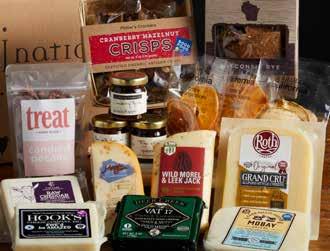
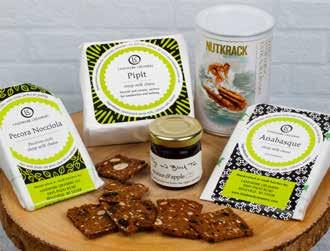
One evening last winter my doorbell rang and there was my neighbor with a glass of clear liquid. “Here, taste this,” they said, thrusting the glass in my direction when I opened the door. “Oh that’s delicious! State Line Vodka, right?” My neighbor looked confused. “How’d you know? Yeah, but what’s going on with it? It doesn’t taste like the vodka I usually buy.”
Before John Mleziva opened State Line Distillery in 2017 on the near east side of Madison, he trekked to Edinburgh, Scotland for a Master of Science in brewing and distilling at Heriot-Watt University. His initial intent was to focus on brewing and open a brewery in Wisconsin. Yet, once in the program, Mleziva became increasingly fascinated with distilling and the opportunities to influence the flavor of spirits within the process. Additionally, he became steeped in the way

the specifics of place influence Scotch Whisky and saw an opportunity for a similar approach in other distilled products. As such, his plans shifted to become State Line Distillery’s deceptively simple-sounding approach: Make spirits that reflect Wisconsin flavor and connect that back to the community.
The State Line Vodka that confused my neighbor manifests this approach in its barest form, showing off the flavor of wheat grown at Sprecher Farm in Lone Rock, Wisconsin, along with a bit of local barley. There are cereal and pastry-crust-like aromas with low chamomile and roasted pear notes. The flavor gives an impression of challah and nutty wheat berries, plus a touch of lemon flesh, a whisper of allspice and, of course, alcohol. “You’re used to drinking carbon-filtered industrial neutral grain spirit,” I told my neighbor. “This has flavor!”
Riffing on that same 87% wheat and 13% barley base, State Line makes three different gins—their new London Dry Gin, their original American Gin, and Barreled Gin—and an aquavit. There is a recognizable State Line character running through all of these, from those Driftless region-grown grains and the choices made throughout the fermentation and distilling process.
In the opposite direction, State Line’s new London Dry Gin is completely ethereal. This is still the same grain base as the others, yet through the combination of a lower fermentation temperature and higher bottling proof, the body is lighter and the flavor has a toasted white bread quality. Notes of cucumber lead on the nose with a bit of prickly ash, peppercorn and blood orange swirling throughout before the juniper cuts in, grounding the initial heady impressions— perfect for a martini.
Barreled Gin starts life as the American Gin but takes a rest in used barrels for a paradigm shift. Citrus aromas swirl with juniper notes for a prickly ash impression with a bit of vanilla, peppercorn and sarsaparilla. The grain base seems so much richer here with the added structure and vanilla notes from the barrel. It can work equally well in classic gin or whisky cocktails, making the difference between a manhattan and a martini entirely academic. Similarly the aquavit benefits from time in a barrel for a bit of a spice-cake impression between the rich grain, vanillins from the wood and the blend of spices.
The American Gin is bold with an unctuousness that makes it a cocktail superstar. Locally grown sage is out front throughout, along with a grainy graham cracker and pastry crust impression. Floral and coriander flavors swirl beneath with a gently bitter juniper bite balancing it all. As the low sage aftertaste lingers, the floral notes grow into a glow of violets. This gin makes brilliantly refreshing short drinks with just a bit of citrus or vermouth, and holds its own even when your G&T is prepared by someone prone to using too much tonic water. It also works great to pull a range of other flavors into a focused whole; head to State Line’s cocktail lounge for a Smoke Show made with American Gin, smoked black tea, lemon, honey, ginger, lemongrass, and organic cane sugar.

State Line’s connective approach, beyond flavor propositions, is central. “If you can’t tie it back to the community in some way, where we make this stuff, what’s the point?” Mleziva asks. In the last weeks of summer, they put on a fundraiser for Clean Wisconsin with Muskellounge, an Oktoberfest-themed event for Breast Cancer Recovery Foundation at the Bur Oak with Young Blood Beer Company, and sponsored a meat raffle at The Dive Inn for the Schenk Parent Teacher Organization.
Working with fellow beverage producers is important to Mleziva too. “The growing number of producers in our area natural ly creates an environment that fosters collaboration and friendships. The quality of what’s being produced elevates everyone. We push each other to do better, even across beverage types. People here are passionate about what they do and creating something unique to their subcategories. The vibrancy of what we’re doing will just continue to expand.”

The connections to the community go right down to the micro scopic level at State Line with the distilling of their rum pulling flavors from Wisconsin in a completely different way. “Producing rum has been really interesting, and has given us the opportunity to stretch ourselves as distillers. By creating our own dunder pit that is inoculated with microbes from right here, we are able to play with those flavors and have them be expressed in the finished rum.” Said dunder pit at State Line may look like an ordinary tote, yet it holds the variety of life needed to ferment the molasses base into something complex, yielding a compelling distillate. The dunder pit is the source of the roasted banana, low cherry pit, light lemon seed and suggestion of maraschino that complement the burnt sugar and molasses flavors. All of the complexity comes from nurturing ongoing life in this specific place, while the weight of the liquid on your palate, along with the quality of the alcohol flavor, give a clear tie to the State Line profile found in the grain-based spirits.
Like most other small producers, the onsite aspects are import ant, yet the centrality of the cocktail lounge has been a delightful surprise to Mleziva. “I didn’t expect we’d create such a deep connec tion with members of the community through the cocktail lounge. From having people taste the spirits, trying to source local ingredi ents, and having passionate people working behind the bar, we have been able to create brand ambassadors throughout the entire city and beyond. It’s fun because we are able to engage with people in an open and honest way and get folks invested in what we’re doing.”
Invested patrons are hardly surprising: sleek, warm wood, longterm staff—the cocktails! Plus, there are a few spirits designed to enhance the onsite cocktail program; distilleries in Wisconsin are only allowed to serve spirits they produce. The bright red Aperitivo leads with bitter herbs before revealing vanilla, black-cherry skin, a slight yellow cake note and warm spices. Once a collaboration vermouth with American Wine Project is ready, the door is open for serving Wisconsin-centric versions of americano and negronistyle cocktails. The Coffee Liqueur, made using Madison-based Kin-Kin Coffee, plays like a nutty pour-over and allows for classics like a White Russian on the menu.
“If you can’t tie it back to the community in some way, where we make this stuff, what’s the point?”John Mlesiva stands by his still.
There is also a new neighbor just behind the cinderblock wall to garnish your trip to cocktail court. In spring 2021, Hastings Cameron opened Imaginary Factory, a blending and bottling operation, to explore the flavor possibilities at the limits of classic builds. Classics like a mint julep become the Electro-Julep built off the house Old-Fashioned with mint, ginger and coco nut water. “It’s great to have Hastings next door and to see the success of his experi mental cocktails. It’s a complement to what we’re doing with our elevated classic cock tail program and brings more people out to experience cocktails and beverages that are locally made. I love what he’s doing over there—everybody wins!” Mleziva says.

And this is just the beginning. State Line Distillery was initially born from Mleziva’s interest in Scotch production, and a range of mature whiskey is on the way. Expect a fiveyear-old Wisconsin single malt sometime in 2022. “Whiskey is the culmination of having the patience to give the spirit enough time to become what it truly is intended to be. One question we always ask ourselves is how can we find ways to use local ingredi ents and preserve the flavors that are unique to this area throughout the distilling and aging process? This single malt whiskey is 100% Wisconsin barley with flavors that are unique to this area,” Mleziva explains. “But in my mind, whiskey is the sub-story. There’s a definitive State Line flavor profile that people have really embraced and gets them excited about new products we release. How we use terroir and have that come all the way through to your glass is the main story that is told across everything we make.” This is Wisconsin distilled.

At 7 years old, I walked into my grandmother’s kitchen, high on a ridge in the Driftless region, just outside Richland Center. I scooted right in, kneeling on a chair alongside older cousins; the aroma of fried, sweet dough in the air. Her kitchen was my favorite place, with big windows looking over the land, a dining table that could accommodate a crowd, and a fieldstone fireplace with a small kitchen witch poppet hanging at the mantle, evoking our northern European heritage. The tag around the witch’s neck shared a message that the power to keep roasts from burning, pots from boiling over, and plates from dropping was somehow out of worldly control and in the magical protection she provided this place. Grandma was working over a bubbling pot, making rosettes for the holidays: airy, light fried cookies in the shape of snowflakes that are served with a dusting of sugar. Impossibly simple in theory, but tech nical in execution!
I hopped in to take part in this master class as she was teaching us how to tell when the oil was just right—using a thermometer, but also knowing what to look for. “Too hot and the batter will burn on the edges before it cooks through, too cool and you will have oil-soaked cookies.” I learned
how to heat the rosette irons and keep them clean, how to release the dough, and how to sift the sugar gently, leaving some of the golden cookie peeking through. We gobbled up the ones that didn’t turn out quite right.
This sharing and passing down of holiday food tradition, with all the details that are rarely shared on the recipe card is the real charm—the sense memory and the connection to the people of our past. Taking time to prac tice these traditions in our kitchens now and adjust them to the pace and space of our modern lives helps tether us to our family history and identity. It gives us space to be present with those memories and make new ones, with a sweet reward.
I love asking friends about their own favorite food traditions and watch for that far-off look, that sparkle in the eye, that comes with the delight of recalling a delicious bite or a precious time. Here, we gather together a few of these recipes and stories, providing inspiration for you in your festive kitch ens, to share or reclaim your traditions and explore something new, inspired by the magic of our grandmother’s hands.

Serves 36 rosette cookies
Prep time: 15 minutes
Cook time: 40 minutes to 1 hour, depending on the number of irons
2 eggs
1 tablespoon sugar
1/4 teaspoon salt

1 cup all-purpose flour, sifted
1 cup whole milk
1 teaspoon vanilla
Oil for frying (Grandma always used vegetable oil)
1 cup confectioners’ sugar
OR
1 cup granulated sugar whisked with 2 teaspoons cinnamon

1. Beat the eggs with 1 tablespoon sugar and 1/4 teaspoon salt.
2. Whisk half the flour into the egg mixture, then half the milk, blending until smooth. Repeat with the remaining flour and milk; stir in the vanilla.
3. The batter should be very smooth and the consistency of a thin pancake batter, the batter should coat the back of a spoon well, but drip off. If it is too thick, add a teaspoon of milk at a time. The consistency of the batter is critical. If you have any lumps, strain them out.
4. Heat 3 inches of oil in a deep, heavy-bottomed pot or in a deep fryer to 365 degrees F. Place the clean and dry rosette iron in the hot oil for 60 seconds. The iron must be hot.
5. Lightly stamp the iron on a clean dry cloth to remove excess oil, then dip the hot iron into the batter, making sure not to let the batter run over the top of the iron. If you do, the rosette will be impossible to remove.

6. Immerse the coated iron in the hot oil; fry for 25-30 seconds until light brown. Use a metal spatula or butter knife to loosen the cookie from the iron and place the cookies on a towel- lined rack to drain and cool.
7. Dust with confectioners’ sugar or cinnamon sugar mixture while still warm. Find the recipes online at ediblemadison.com/ grandmothershands

My favorite baking tradition is making pound cakes before Thanksgiving and Christmas dinner, a tradition that comes from my 98-year-old greatgrandmother Louise Dunlap. She’s been baking pound cakes since she was a young girl, and her and my Big Momma (grandmother) Melva, have always kept the tradition alive. They both still work together to prepare our family holiday dinners to this day!
do know is that pound cake was an easy recipe passed down orally to people who couldn’t read and write. That is where the name comes from, adding one pound of every ingredient. As time went on, portions were adjusted and leaveners were added to lighten the cake.
by Emily McCluhanI feel like I’m able to connect to my history by preparing and eating things that my ancestors created and/or thrived on. It’s always so hard to pinpoint the exact history of the Black Foodways, but one thing we
Now, I am a descendent that is furthering the innovation of this truly historic dessert. The tradition still shows up at almost every family gathering. And I like to add a modern spin to the pound cakes by diversifying the flavors. I’ve made strawberry cream pound cake, peach cobbler pound cake, sweet potato pound cake, and many other varieties.
Adapted from an article that first appeared in The Milwaukee Journal Sentinel, December 21, 2008. Reprinted with permission.
Beyond my mother’s perfect King’s-standard British English, there was food. Perhaps the most important dish was the plum pudding she steamed for hours at Christmas. She brought it to the table almost black, decorated with a sprig of holly, and flaming gently blue with brandy, the crowning dessert after a dinner of roast goose. She never mentioned how Christmas pudding became part of her family’s tradition. There was no family recipe handed down over generations, no special pudding basin taken down from the shelf
and covered with cheesecloth for steaming. And my mother didn’t follow any of the British customs associated with the pudding. She never insisted on each of us stirring the dough clockwise, mimicking the sun’s movements; never stuffed it with a silver coin, also for good luck; and never served it with hard sauce. Rather, she would put out a dish of granulated or confectioners’ sugar in deference, she said, to those who had a sweeter tooth than was probably good for them.

CON CYNTHIA GARCIA Full English translation by Jenina Mella available online at ediblemadison.com.
Viviendo aquí en los estados unidos con mi mama y mi hijo, invitamos a los familiares más cercanos si en caso no vamos a nuestro país. Preparamos nuestro puerco al horno con un delicioso arroz arabe preparado por mami, chocolate caliente y su infaltable panetón en la mesa. Creo que no hay Peruano que deje de tener un panetón en la mesa para la cena navideña. Es una tradición que adoptamos en el transcurso de los siglos de los Italianos que ahora es parte de la costumbre en sudamérica.
Lo que sí extraño mucho es cuando mi madre hacía su chocolatada para todos los niños del barrio. Solíamos ir de compras para darle unos pequeños obsequios a cada niño. 23 de Diciembre, despiertos con el olor a chocolate y cortando los panetones y untarlos de mantequilla y escuchar los niños felices sentados en las mesas, esperando por su chocolate caliente y tajada de
panetón. Una pequeña fiesta con los payasos haciéndonos divertir y al final proceder con fila para entregar los obsequios a los niños. Eso es gratitud, la que mis padres me enseñaron, retribuyendo de una manera positiva a la comunidad después de todo lo bueno que pudimos obtener durante el año.

“THAT IS GRATITUDE, WHAT MY PARENTS TAUGHT ME, TO REWARD THE COMMUNITY IN A POSITIVE WAY AFTER ALL THE GOOD WE WERE ABLE TO ENJOY DURING THE REST OF THE YEAR”.
My first experience with an oyster was at a bar in Lansing, Michigan. The happy-hour special was an oyster shot—basically a giant booger in a shot glass with pepper vodka and a dash of Tabasco. I downed it and swore I would never eat another oyster.
Fast-forward a few years and I’m at a client dinner in Philadelphia when someone ordered a dozen for the table. I demurred and said I would pass. But then the server placed a circular plat ter filled with ice and these alien creatures from the sea in the middle of the table and proceeded to explain each with the grace and knowledge of a sommelier. Wait, oysters aren’t just slimy boogers? My curiosity was piqued; I had to try them.
This experience is what Phillip Hurley and John Gadau, co-owners of Sardine in Madison, were shooting for when they opened the French-in spired bistro in 2006. They saw an oyster-sized gap in the Madison restaurant scene and decid ed they needed to fill it with their knowledge
and love of this diverse shellfish. Now, Hurley says they go through hundreds of oysters a day, placing orders every day except Sunday to rotate through two varieties of East Coast oysters and two varieties from the West Coast. But Hurley understands the trepidation for a beginner (or someone who is scarred by bad choices in Lansing bars).
“For first-timers, oysters are unfamiliar, the texture [can] be daunting, I get it. But it’s a celebration. It’s a process. There’s something beautiful about sitting down and starting a meal off with something that has a story.”
He explains that just like wine regions, the ocean has a terroir, called a merroir, that defines an oyster: what they feed on, the land scape where they are cultivated, the tempera ture, minerality and salinity of the water. All of these influence the flavor, size, texture, even the shells. Knowing these differences can be a portal to accepting oysters into your life.

Hurley suggests starting with an oyster that has smaller meat, or belly, to get used to the texture and flavor. Generally, East Coast oysters from Chesa peake Bay all the way north to Nova Scotia and New Brunswick will be firmer with a briny flavor. Names like Wellfleet, Malpecque and Raspberry Point are popular at restaurants like Sardine.
“Pink Moons from Prince Edward Island are smaller in size and have a nice salinity, so they’re sort of briny. They’re a great starter oyster,” says Hurley.
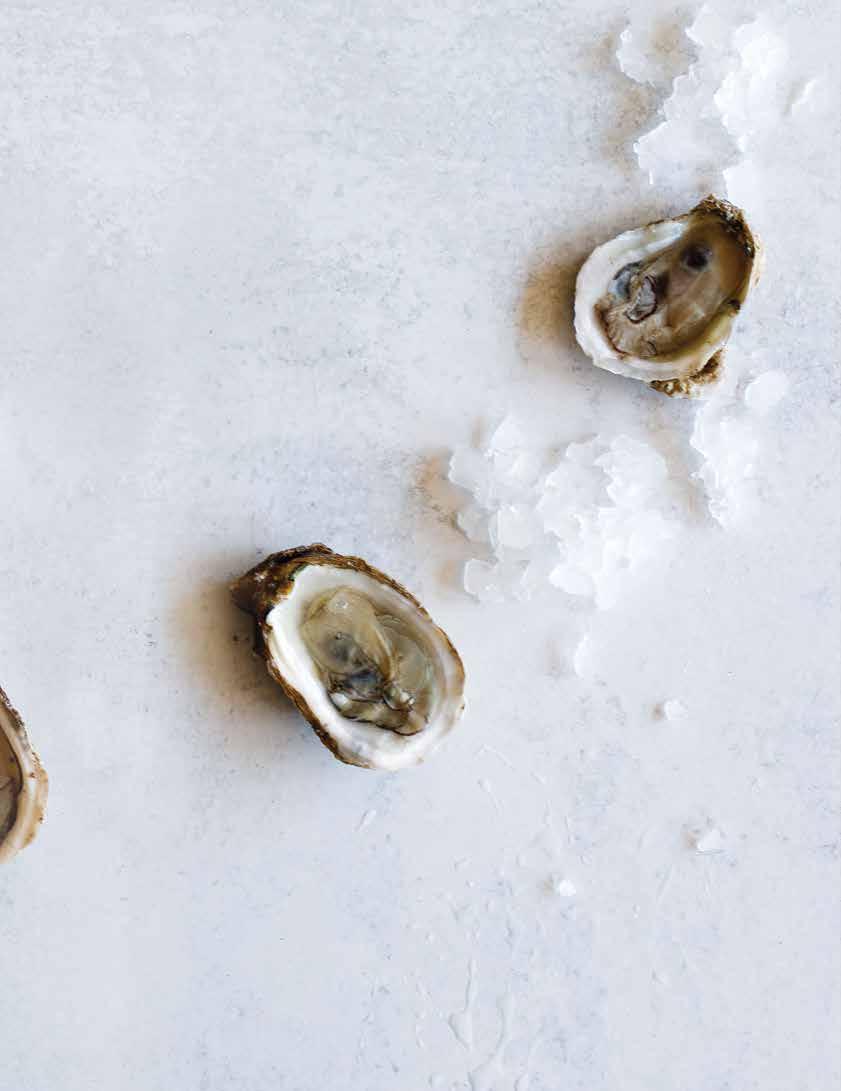
On the West Coast, in regions like Puget Sound, British Columbia and the Bay Area of California, the oysters are smaller with fluted shells. While an East Coast oyster, especially those from the north, can take up to four years to mature due to the colder water in the northern Atlantic, most Pacific oysters grow to maturity in under three years. That means less time for the salty flavor to embed in the meat, leaving the West Coast oysters more delicate and creamier with notes of melon and cucumber. The small meat and deep cup also make them easier for newbies to slurp.
“The most popular West Coast oyster is a Kumamoto, which has a deeper shell than other West Coast with smaller meat inside, but texturally is very creamy,” says Hurley. “So if you’re newer to oysters or hesitant on the texture, Kumamotos might be a little creamier than you’re ready to jump into.”
Other common West Coast oysters include Miyagi, Kusshi and Baynes Sound, all characterized with a creamy texture, and melony, yet salty bite.
Not all oyster presentations are so refined, but that doesn’t mean the oyster lover is less refined. When it comes to accompaniments for the oysters, the mignonette is the standard prep at Sardine, but the staff is often asked for other common toppings like cocktail sauce or horseradish. These will all add different flavors but might cover up the complexity of the oyster itself.
So do you chew them? Kind of, says Hurley. At Sardine, the presentation is classically French. The plate of oysters is served with a mignonette (pronounced min-yun-net), which is simply champagne vinegar, finely minced shallots and a twist of black pepper.
“The idea is that the mixture of the mignonette and the liquor [the liquid inside the shell] creates a simple addition so the flavor of the oyster shines,” says Hurley. “Just slurp it all into your mouth, push it around, and agitate it a bit to release all of those flavors. I don’t necessarily chew them, but I gently crush the meat with my teeth before swallowing.”
Prefer to just take it down the hatch? Go for it, says Hurley, but suggests that keeping the oyster in your mouth longer allows you to experience more of the flavor notes, similar to tasting wine.
Warm water oysters from the Gulf of Mexico, Florida and the Carolinas tend to be larger and less delicate. You can find these at Hurley and Gadau’s other Madi son establishment, Gates & Brovi. Hurley says spicy horseradish or tangy cocktail sauce stand up to the richer, meatier flavor of these Southern versions.
“It’s just a different experience. Sit at a big table with friends and slurp down some oysters. It makes you feel like you’re sitting on a beach somewhere down south,” he says.
Finding an oyster with a strong shell is step one for those new to prepping them at home, suggests Jim Berke, owner of Berke & Benham Seafood in Madison.
“I recommend Chesapeake Bay varieties because they have stout shells, easy for shucking, but the meat can get large so they might not be great for eating raw for a beginner,” he says. “West Coast shells tend to be more brittle and harder to shuck, and they don’t tend to have the longevity as the East Coast.”
Scared to shuck? Ask your fishmonger for a quick demonstration, or Berke suggests streaming one of the hundreds of YouTube videos available online while you shuck the first time.
He also notes that longevity is key when buying oysters to eat at home. His rule is only buy them if you plan to eat them in the next two days and store them low and in the back of the refrigera tor to protect them from temperature changes as the fridge door opens and closes. If your oysters are on day three in the fridge, Rob Kitto, owner of Lake Edge Seafood in Madison, says there are a few telltale signs for knowing if an oyster is still edible.
“If the shells have started to open, it could mean the oyster isn’t viable anymore. When you open it, there should also be plenty of liquid inside and the meat should look nice and juicy. If it’s dried out, definitely avoid it,” he says. “And the smell. If it has a pungent odor that doesn’t smell like salt water, toss it.”
Both shops typically stock one or two varieties of East and West Coast oysters. Berke says he also carries a frozen Gulf oyster on the half shell, which he says is perfect for thawing and throwing a big pad of butter on before grilling.
Whether you’re experimenting with raw or grilled oysters at home, or going for the full celebration experience at a local establishment, Hurley says to embrace your beginner status.

“At a place like Sardine that specializes in oysters, the staff is knowledgeable from the bartenders to the wait staff. It’s not a problem to say, I’m a begin ner. That’s totally fun for us,” he says. “Maybe try one, try three. Then figure out what tastes best to you.”
So grab some friends, ask questions and experi ment with this weird, delicate and diverse shell fish. Learn their stories and find a few experts. Chances are you’ll be coming back for more.
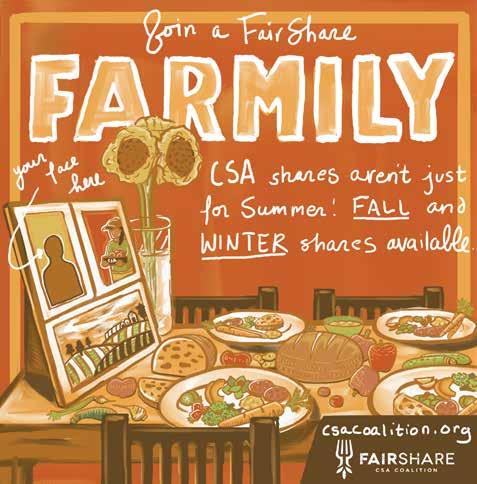

With a food as delicate and complex as oysters, pairing the right beverage can make the flavors sing. We asked our oyster experts for their recommendations.
Bubbles and oysters are a festive match, Hurley says. The fizziness of Champagne contrasts with the soft texture of the meat, and the acidity of the drink brightens the creaminess of some oysters. Hurley recommends sticking to a dry Champagne to keep the flavor of the oyster as the star.
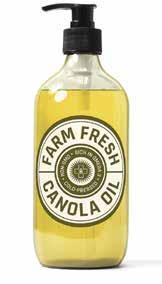

Susan Schueller, general manager and wine director at Sardine, says Muscadet is the classic oyster/beverage pairing. “It comes from the Loire region right on the Atlantic Ocean, so you get that saline and a little bit of lemon-lime. It all just elevates the oysters.”
“A crisp, tart cider actually goes perfectly with the brinier East Coast oysters,” says Berke, explaining that the tartness contrasts with the acidity and salinity of the sea. He recently discovered a black currant cider from Brix Cider in Mount Horeb that provides a bubbly, dry tartness, perfect for chasing an oyster.
While a stout beer seems like the direct opposite of Champagne, Hurley says the bitter taste pairs well with briny oysters and likely dates back hundreds of years. He suggests Guiness if you go the stout route for its sharp bite and creamy finish.
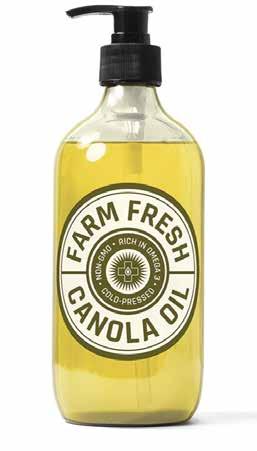
A citrusy shrub and soda is a great non-alcoholic alternative that brings the bright acid flavor to compliment oysters. Sardine currently offers an orange thyme shrub with lemon juice, orange juice and soda water (shown in the photo to the left).
Left: Oysters from around the world, paired with Champagne, blush cider and shrub.
Thanks to Vitruvian Farms and Raleigh’s Hillside Farm for supplying produce for our Cook at Home winter recipes.


Roast turkey. Spiral ham. Roast beef. Leg of lamb. I’ll never understand why our winter tables always put meat front and center, and shove vegetables off to the side. I might be biased (I am an organic vegetable farmer after all), but even in winter, I believe seasonal vegetable dishes deserve the spotlight a little more often. With their vibrant colors, varied textures and playful flavor combinations, these vegetable platters are sure to make your winter gatherings a whole lot more interesting.

No holiday feast in Wisconsin is complete without a relish tray. I was brought up with a sprawling relish tray served as an appetizer at every party and honestly, I loved it. But as I’ve grown older, I can’t help but wonder why we serve broccoli red bell peppers and cherry tomatoes on our relish trays twelve months of the year. It’s time for something more seasonal.
Serves 6–8
Prep time: 20 minutes
Cook time: 90 minutes (if making all three spreads)
1 medium sweet potato, halved and cut into ½-inch slices
2 pounds fingerling potatoes, halved lengthwise if large ¼ cup olive oil, divided ¾ teaspoon kosher salt, divided ½ teaspoon freshly ground black pepper, divided
1 pound Brussels sprouts, halved ½ baguette, sliced
Quick Pickled Beets (recipe follows)
Cashew Aioli (recipe follows)
Walnut Mushroom Pâté (recipe follows) Garlic Yogurt Sauce (recipe follows)
1 bunch radishes, greens removed, roots thinly sliced
2–3 watermelon radishes, halved and thinly sliced
8 carrots, quartered Crackers, optional Microgreens, optional
1. Preheat the oven to 400 degrees F.
2. On one sheet pan, toss the sweet potato and fingerling potatoes with 2 tablespoons olive oil, ½ teaspoon salt and ¼ teaspoon pepper. On a second sheet pan, toss the Brussels sprouts with 1 tablespoon olive oil and the remaining ½ teaspoon salt and ½ teaspoon pepper. Roast for 15 minutes, toss and roast until the edges of all veggies are crisp, about 10–15 minutes longer. You may need to remove the pan of Brussels a couple minutes before the potatoes.
3. To make the crostini, add the baguette slices to an additional baking sheet (or combine all roasted vegetables on one sheet when finished). Drizzle with the remaining tablespoon of olive oil and bake until crisp, about 10 minutes.
4. Pour the pickled beets and spreads into serving bowls and place them on a very large platter. Add the roasted potatoes, sweet potatoes and Brussels to the platter while still warm. Lastly, add the crostini, radishes and carrots, as well as the crackers and microgreens.

2 medium beets, peeled and very thinly sliced
2 tablespoons sugar
3 tablespoons rice wine vinegar
1 tablespoon white wine vinegar
½ cup hot water
1½ teaspoons kosher salt
1. Place the sliced beets in a pint mason jar.
2. In a small bowl, combine sugar, vine gars, water and salt. Stir until the salt and sugar are dissolved.
3. Pour the liquid over the beets and seal the jar. Place in the fridge until ready to use. Can be made an hour before serving or up to 2 months in advance.
INGREDIENTS
¾ cup raw cashews
1 cup water, divided
2 peeled garlic cloves
1 tablespoon lemon juice
1 tablespoon olive oil ¼ teaspoon kosher salt
1. In a small saucepan, combine the cashews with ½ cup water. Bring to a boil over medium heat and cook until the liquid is gone, 5–8 minutes.
Add the cashews to a food processor with the garlic and remaining ½ cup water. Blend until smooth, about 2 minutes. Add the lemon juice, olive oil and salt, and blend until just combined. Serve warm or chilled.
INGREDIENTS
1 tablespoon butter
1 medium shallot, minced
1 garlic clove, minced
3 ounces shiitake mushrooms
3 ounces oyster mushrooms
1 teaspoon kosher salt
¼ teaspoon pepper
2 tablespoons dry red wine
3 ounces goat cheese
½ cup toasted walnuts
1. In a large skillet, melt the butter over medium heat. Add the shallot and cook until softened and fragrant, about 3 minutes. Add the garlic and saute a minute longer. Add the mushrooms, salt and pepper, and cook until the mushrooms are softened, about 5 minutes.
2. Add the wine to deglaze the pan. Once the liquid is reduced, add the goat cheese and cook until it’s incorporated into the mushrooms.
3. Add the mushroom mixture to a food processor along with the walnuts and process until combined but still retaining a bit of a crunchy texture. (This can also be made up to 2 days in advance. The flavor gets better with time.)
INGREDIENTS
8 garlic cloves, unpeeled
½ cup full-fat Greek yogurt
2 teaspoons olive oil
1 teaspoon fresh lemon juice
½ teaspoon kosher salt
1. In a small skillet, roast the garlic over medium heat. Cook for 10 minutes until the skins are blackened in places. Allow to cool and then peel and roughly chop.
2. Add the garlic to a small bowl followed by the remaining ingredients. Stir to combine.

Red cabbage is one of winter’s most overlooked and truly beautiful foods. Braised here with some of the bacon from Dan Fox’s own farm, Willow Creek Farms, and a healthy amount of vinegar, it takes on a complex flavor that will have you seriously excited about cabbage.

Serves 4–6
Prep time: 10 minutes
Cook time: 40 minutes
1 teaspoon juniper
1 teaspoon coriander
1 teaspoon whole peppercorns
1 bay leaf
1–2 sprigs fresh thyme
3 ounces bacon, diced small (Heritage Tavern uses Willow Creek Farms bacon ends)
1 red onion, julienned
4 cloves garlic, minced
1 head purple cabbage, cut into quarters, core removed, julienned (food processor works well)
1 tablespoon kosher salt
¾ cup red wine vinegar
⅓ cup dry red wine
1. Preheat the oven to 350 degrees F.
2. Combine the juniper, coriander, peppercorns, bay leaf and thyme in a tea infuser or cheesecloth bundle.
3. On the stove top, heat a Dutch oven over medium-high heat. Render the bacon until cooked partway through, then add the onions and garlic and cook until they sweat (do not let them color). Add the cabbage and the salt to help it break down. Sweat the cabbage until it loosens up, a few minutes.
4. Deglaze the pot with the red wine vinegar and red wine, and add the sachet of herbs and spices. Put the lid on the Dutch oven and put it in the oven to braise for about 20 minutes.
5. See how much liquid is left, and if there’s a lot, continue to cook until it reduces and the syrup becomes like a glaze.
 Recipe by Dan Fox of Heritage Tavern and Willow Creek Farms
Recipe by Dan Fox of Heritage Tavern and Willow Creek Farms
Always trust a farmer to bring a big, delicious bowl of greens to the winter table. This one, adapted from Samin Nosrat’s Salt, Fat, Acid, Heat, brings together creamy squash with crunchy butternut and hazelnuts on a bed of kale.

Serves 4
Prep time: 10 minutes
Cook time: 60 minutes
INGREDIENTS
4 tablespoons olive oil, divided
1½ teaspoons kosher salt, divided
1 large butternut squash, peeled, seeds removed and cubed
5 slices sourdough bread
1 red onion, thinly sliced
2 tablespoons red wine vinegar

6 tablespoons butter
1 tablespoon finely diced shallot
1 clove garlic, crushed and finely diced
2 tablespoons balsamic vinegar
¼ teaspoon black pepper
½ cup hazelnuts, coarsely chopped
1 bunch lacinato kale, stems removed and thinly sliced
Recipe by Bethanee Wright of Winterfell Acres1. Preheat the oven to 425 degrees F.
2. On a baking sheet, drizzle the oil and salt over the butternut squash. Roast until soft and starting to brown, about 35–40 minutes.
3. To make croutons, chop or tear the bread into bite-size pieces and place them on a second baking sheet. Drizzle with the remaining 2 tablespoons olive oil and ½ teaspoon salt. Roast until brown and crispy, 10–15 minutes.
4. Toss the sliced onion with red wine vinegar and let sit for at least 20 minutes to macerate and mellow the intensity.
5. Place the butter in a wide saucepan and melt over medium heat. Once it’s melted, whisk it continually while it bubbles until it clears and you start to see little brown bits at the bottom. It should smell like butterscotch. Immediately take it off the heat and allow it to cool.
6. Add the finely diced shallots and garlic to the balsamic vinegar and let it sit for 10 minutes to macerate. Add the cooled brown butter along with the black pepper and remaining ½ teaspoon salt. Whisk until smooth.
7. Place the hazelnuts in the saucepan you used for the brown butter. Toast over medium heat, stirring occasionally, until they smell nice and nutty, about 8 minutes. Set aside.
8. Mix the kale and half the croutons in a large salad bowl with half the brown butter vinaigrette. Let sit for 10 minutes.
9. Add the remaining croutons, squash, hazelnuts and macerated onions with red wine vinegar to the salad bowl. Dress with the remaining vinaigrette and season with additional salt as needed.
The one vegetable that is never forgotten at festive winter tables is the star of storage season: the potato. This recipe brings a bit of extra energy to otherwise ordinary mashed potatoes. Sautéed leeks are folded into creamy mashed potatoes before heading into the oven to puff. Think twice-baked potatoes without that pesky skin getting in the way.

Serves 6-8
Prep time: 10 minutes
Cook time: 55 minutes
6 tablespoons unsalted butter
2 pounds leeks, white and pale green parts only, halved and sliced
4 garlic cloves, minced
2½ teaspoons kosher salt, divided
2½ pounds gold potatoes, unpeeled, cut into large chunks
1 cup heavy cream
½ cup whole milk
½ cup Greek yogurt
½ teaspoon black pepper
1. Preheat the oven to 425 degrees F.
2. In a large saute pan, melt the butter over medium heat. Add the leeks, garlic and ½ teaspoon salt. Reduce heat to medium low and cook until the leeks are fragrant and tender, about 10 minutes.
3. In a large stockpot or soup kettle, cover the potatoes with an inch or two of water. Add 1 teaspoon of salt. Bring to a boil over high heat and cook until the potatoes are fork tender, about 10 minutes. Turn off heat, strain and return to the stockpot. Add the cream, milk, yogurt and pepper. Mash until the potatoes reach desired smoothness. They will have a bit of texture due to the potato skins, which is just fine, because the leeks will add some texture too.
4. Add the sautéed leeks and garlic to the pot along with the remaining teaspoon of salt. Fold the leeks into the mixture. Transfer to a 3-quart baking dish (or 9x13 pan). Decoratively swirl the surface.
5. Bake until golden brown and slightly puffed, 30–35 minutes.

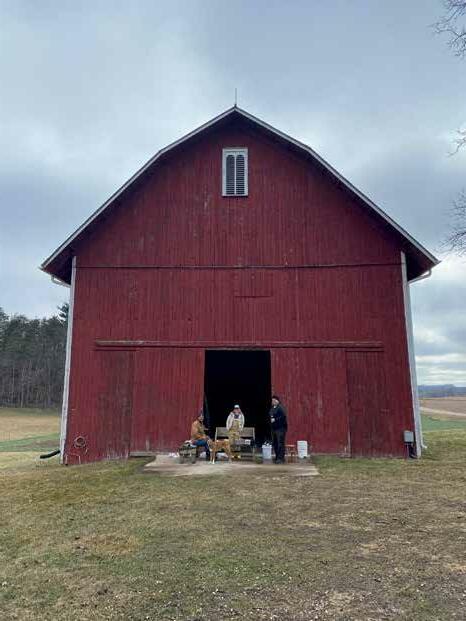


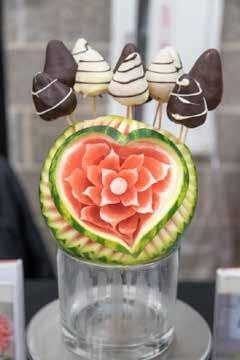
At Edible Madison, we’re committed to eating locally, but seafood often must travel thousands of miles before reaching Midwesterners’ dinner plates. Three Madison-area companies, Sitka Salmon Shares, Berke & Benham, and Bering Bounty, are on a mission to make sustainable seafood attainable by freez ing quality fish, selling farmed fish and building direct links between fishermen and eaters.
Marsh Skeele was born to two commer cial fishermen. His mom was pregnant with him when she was halibut fishing off the coast of Alaska.

“As soon as I was able-bodied age, 11 or 12,” says Marsh. “I was on the boat the whole summer with my dad. I’ve been doing it ever since.”
Eventually he began to seek/sought an alternative to commercial fishing.
“You put all this work in to have a beauti ful fish and then it’s a commodity,” says Marsh. “I wanted to share that beautiful piece of fish with somebody and have them be excited about it.”
He co-founded Sitka Salmon Shares with UW-Madison graduate Nic Mink. Their goal is to connect small-scale fishermen with Midwesterners. It was a natural fit for Sitka Salmon Shares to start in Madi son—a strong food community that cares about supporting the right kind of fishing and agriculture—before expanding to other cities.

They offer monthly subscriptions, or shares, of frozen fish. Don’t let the name fool you—Sitka Salmon Shares dishes out way more than salmon. The 2021 catch included Alaska king salmon, sockeye salmon, coho salmon, keta salmon, lingcod, black rockfish, sable fish (black cod), Pacific cod, yelloweye, rockfish, bairdi crab, Dungeness crab, albacore tuna, and halibut. All of their fish is wild-caught in Alaska, except for the albacore tuna—which comes from off the coast of Washington and Oregon. The fish is then frozen to maintain its freshness and transported throughout the country.
“What we’re looking for in our sourcing is minimal impact on the environment,” says Skeele. “So making sure we’re not taking all of the fish in the harvest and that what is harvested isn’t detrimental to the environment as well.”
Sitka strives to be transparent about their sourcing. They built a rubric of seafood sustainability to rate all of the different factors that go into a seafood choice. It includes where the fish is harvested, the gear used, how much bycatch there is, the type of fish, if the fish is endangered, and the socioeconomic impact of fishing the species.
“It’s better to support a bunch of domestic fishermen,” Marsh says, “than a multina tional company that consolidated a bunch of fishing rights.”
One-time boxes or monthly subscrip tions are available. Newly added winter subscriptions start January 2022. SitkaSalmonShares.com @sitkasalmon
BYCATCH: the portion of a commercial fishing catch that consists of marine animals caught intentionally.
Merriam Webster Dictionary
Coral wallpaper hangs on the back wall of a shop on Monroe Street. Hand written signs denote seafood types and origins.
Jim Berke is the owner and founder of Berke & Benham, a new fish market located next to Brasserie V on Monroe Street. He and wife Kate Spring wanted an old-fashioned name; Berke is his last name and Benham is the maiden name of Kate’s grandmother.
“We were trying to honor both families as well as have an old-school fish house feel,” Jim says.
Jim grew up in a family business and wanted to offer that legacy to the next generation. Memories of fishing with friends and family as a child, coupled with a desire to get out of a sales market ing career in Chicago led him to pursue working with fish full-time.
“I still remember the first time I went fish ing with my dad and my younger broth er,” he says. “It was a little pond down the street from my house near where I grew up in the northwestern suburbs of Illinois. It’s a bonding moment between parents and a child or friends. It really stuck with me.”
Jim started delivering fish to many of Chicago’s great hotels, restaurants and country clubs while working for Wabash Seafood. The experience of working with chefs and seeing a vari ety of preparations helps him educate Berke & Benham customers about home cooking possibilities.
“I find that consumers are starving for information about how they can really highlight the fish,” Jim says. “[Sharing new recipes] really sparks some ideas about what they can do with seafood instead of taking salmon and throwing it on the grill with some olive oil and think ing that’s good enough.”
During the pandemic, Jim and Kate moved from Chicago to a farm in Mount Vernon. Jim’s new role as a full-time fishmonger allows him to dig into sustainable sourcing.
“I love fish, seafood and our water ways,” Jim says. “I’m interest ed in how they affect us, how we affect them, and how we can always do better.”
Jim wants people to try different varieties of fish, including invasive species, and to consider how they are caught.
“On the Great Lakes, the Asian carp are a huge issue,” he says. “Most people have heard about them. They’re excellent smoked, so it’s a matter of having people go fishing for them and creating an econ omy around it. Eating those fish is a way to control their population.”
In addition to eating invasive species, building a market for lesser-known fish is key to minimizing waste in our food system.

“There’s still a fair amount of bycatch in the world,” Jim says. “So I ask my suppli ers, ‘What’s happening to that bycatch? Is it just being tossed overboard as total waste or is it being saved and offered up as ‘alternative’ fish?’”
Customers relish in the variety of freshand saltwater fish offered at Berke & Benham. Wild-caught fish from the
coasts and Great Lakes, and farmed fish from Wisconsin, Illinois and Canada are for sale.
“Many people think that you can’t get fresh saltwater fish in the Midwest very easily,” Jim says. “That might have been true 20 to 30 years ago when logistics and refrigeration were different. Nowadays, I can get fish from Maine that were out of the water for a day and a half delivered to me directly.”
Most customers cook the fish they buy the same day. Jim hopes to offer wine, beer and Wisconsin-made dried goods soon so customers can make one stop after work to create a delicious meal.
“I hope that people feel like they can ask questions and get them answered honest ly with good information,” Jim says.
BerkeandBenham.com @berkeandbenham
from Jim Berke of Berke & Benham:
• Make sure your fish is patted dry before preparing.
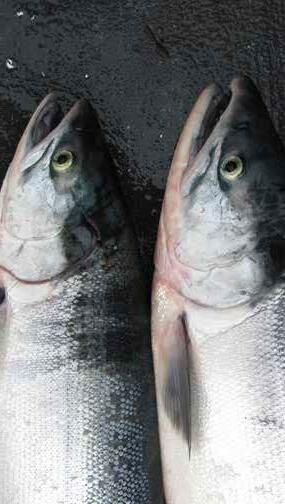
• If your filet has the skin on, lightly score that side with a sharp knife to prevent the skin from curling during cooking.
• For crispy skin, use a very hot cast-iron skillet with a layer of olive oil! Tastes like bacon…
Cooking a whole fish is easy!
Ask your fishmonger for recommendations.
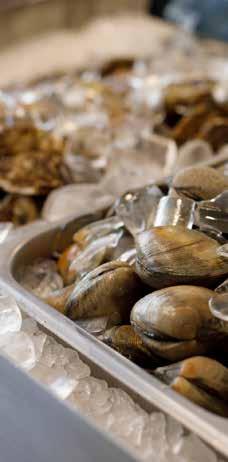
Wisconsin fisherman Mark McKeown founded Bering Bounty in 2008. Fish are wild-caught from the Bering Sea, then processed and frozen in Alas ka. Species include sockeye, coho, king, pink and keta salmon, cod, sole and halibut.


“I have had the immense privilege of crewing and skippering all along the grand Aleutians. Having fished out of Dutch Harbor for many seasons, I have a few hair-raising stories from the ‘cradle of storms’, the Bering Sea,” says Mark. “But perhaps the most important story is that of sustainabil ity, as the thought of the loss of these epic fish is truly terrifying.”
The Conscious Carnivore on Univer sity Avenue sells Bering Bounty’s sockeye salmon. Business manager Bartlett Durand refers to it as the go-to for salmon lovers.
“We’re all about local foods in Wiscon sin,” says Bartlett. “If there’s a way to do ocean fish as a Wisconsin product, if you will, he’s doing it. I’m crazy about where Captain Mark fishes,
how he fishes, the product he’s getting out of it, and the stories about how he treats his crew.”
Find their wild fish at Conscious Carnivore and at restaurants and markets throughout southwest Wisconsin. Individuals can also get fish delivered directly to their home, year-round and free of charge with no long-term sign-up.

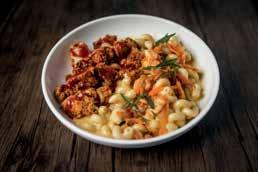
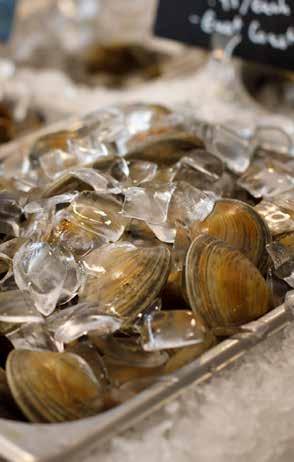
BeringBounty.com
@beringbounty

The Eat Wisconsin
links consumers to Wisconsin fish producers and markets. Their list of commercial fishers and farms that raise fish using aquaponics or ponds includes species available and contact information. The project is spon sored by the Wisconsin Sea Grant at UW-Madison, which fosters the “wise use, conservation and sustain able development of Great Lakes and coastal resources.”

 BY
BY
If we had been told, a decade ago, that so many climatefueled disasters would hit the food system so soon, would we have believed it?
If someone had described the catastrophic flooding of the Missouri river that submerged a million acres of corn and soybeans in 2019 (followed a year later by winds in the same region that were so destructive they flattened corn si los), produce crops in Texas freezing in April, winemakers having to throw away entire vintages because they tasted of wildfire smoke, shellfish in British Columbia being literally cooked alive in the ocean and ranchers throughout the West being forced to sell off tens of thousands of cattle so they wouldn’t starve due to drought—would we have listened? Would we have done more to prepare?
I can’t help but think back to a lecture I sat in on in 2008 on the future of food and climate change by a pair of Ivy League economists. I had seen An Inconvenient Truth and was serious about local food. And I had a hunch that reducing my “food miles” wouldn’t cut it.
The economists talked about the potential boon to crop yields, due to “increased photosynthesis” and “CO2 fertilization,” but added that warming temperature and ris ing evaporation would balance one another out, at least in our lifetimes. Some places would get too wet, and some would be too dry, they warned. And, as if to reassure us,
they said that other parts of the world—developing na tions with little infrastructure and large numbers of subsis tence farmers—would face the worst of the problem. And those of us in North America? We’d be fine until at least the end of the century.
Then someone turned the lights back on, the economists thanked the audience and everyone went home. I wrote about the lecture, quoted the experts on the science and was careful to take a similarly calm tone, as if I were writing from a great distance about something that may or may not occur.
Of course, some climate scientists were already issuing dire warnings at that point, and many had made concerns about our ability to feed ourselves central to their pleas for action.
But most of us had no idea how urgently we needed to prepare for what we’re now seeing play out in the food sys tem—and in the world at large. Indeed, the stakes couldn’t be higher. Food production has been rocked to the core and many small and medium-scale farmers are contemplating throwing in the towel.
This fact was driven home for me this summer, as I trudged through ankle-deep mud on my family’s small farm in Captain Cook, Hawaii—on what was once the “dry side of the island” but has seen record-level, nearly non-stop rain fall for the past year. My mother, a farmer, was dismayed at
It’s Time To Make Food Decisions With the Climate Crisis in Mind
the constant rain’s impact on her orchards, and by the host of new invasive species—from fire ants and wild boars to slugs that carry a brain-eating parasite—that are thriving there due to warming temperatures. The soil has been consistently saturated with water, and the coffee and fruit trees are suffering from multiple fungal diseases at once. The vegetables in the gardens are often stunted and mildewy as the sun has stubbornly refused to shine.
And I thought about those self-assured economists when I returned home to drought-stricken Northern California, where I saved water from my kitchen and shower and lugged it to the tiny garden I struggle to keep alive through the dry season. Most of the small-scale farms in the area didn’t have the luxury of re claimed water; instead, they found themselves abandoning doz ens of acres at a time, making radical changes to their business models, and discontinuing their CSAs. Meanwhile, the ongoing, often terrifying onslaught of wildfires made the mere thought of rain seem like a mirage on the other end of a very long desert.
The fact that these “new normals” have already had a dra matic impact on the food system probably shouldn’t be a sur prise. Global temperatures have already risen 1.5 degrees Celsius above pre-industrial levels and the impacts are evident. The sixth assessment report published by the Intergovernmental Panel on Climate Change (IPCC) in August warned of significant drops in crop yields for corn, wheat, rice and other cereal grains if global temperatures hit the 2 degree C level. If that happens, the report said, there will be “more times of year when temperatures exceed what crops can stand” and “risks across energy, food and water sectors could overlap spatially and temporally, creating new and exacerbating current hazards, exposures, and vulnerabilities that could affect increasing numbers of people and regions.”
Among the clear list of hazards are the “food shocks” caused by extreme weather events—and they show no sign of slowing down. For these reasons, food prices are expected to grow at a steadier clip than most of us have experienced in our lifetimes. According to the United Nation’s Food and Agriculture Organi zation (FAO), for instance, global food prices rose by nearly 33 percent between September 2020 and September 2021.
It’s not just farmers who are scrambling to respond. Many of the world’s largest, most powerful food companies are starting to examine their supply chains in a new light, hoping to posi tion themselves as part of the solution. Multinational food com panies like General Mills, Smithfield, Unilever and Danone are all publicizing the changes they’re making in their supply chains to address emissions and rethink their farming practices. Some of these changes could have a real impact and others might just

be marketing ploys, but it’s clear that they’ve realized “sustain ability” is a term they must use literally, as in, do their business models have a future?
When it comes to making sure the rest of us have a future, however, I’m betting on the work of small-scale farmers and ranchers—and more of them working at a human scale—as one of our most important solutions to the climate crisis.
If done right, farming and ranching can help bring the natu ral world back into balance. And it has the potential to reverse our current scenario: millions of acres of land covered in monocrops growing in soil that is overly tilled, void of most life and actively washing into the ocean nearly every time it rains.
Soil holds three times more carbon globally than the atmo sphere does. And it can hold more if it’s managed in a way that brings more of it back to life. But to do that we need producers who are immensely curious and dedicated—who see the chal lenge at hand and want to rise to meet it.
They need to work in concert, and they need to represent a much wider swath of the population—here in North America that means intentionally making space for exponentially more young people, more Black, Indigenous, and people of color (BI POC) producers, and more LGBTQ producers. It also means passing systemic policies that help them explore, invest in and modernize the farming practices that have long been successful at cooling the planet.
In plain terms that means we need more perennial crops, trees on farms (i.e., agroforestry and silvopasture), managed grazing, cover crops, waffle gardens and other methods of deep-soil plant ing, crop diversity, prescriptive burns, seed sovereignty, local food and farm infrastructure, and multitrophic aquaculture.
We need to help more farmers control weeds without tilling the soil. We need more compost on the surface of the soil and more mycelia and living ecosystems below. We also need more plants at the center of our plates. We need to spend more time listening to Indigenous communities and remembering that our needs are inextricable from the needs of the natural world, and the ecosystems that have kept it in balance for millennia.
Most of this probably won’t require new cap and trade markets, new consumer labels or new technology. But it will require more hands—and very likely a different, more collec tive approach to land ownership, at a moment when building housing is considered a much more valuable use of land than producing food.
None of this will mean much if we don’t also stop burning fossil fuels—and subsidizing that burning on a global scale. But





there’s more and more agreement among scientists and cli mate advocates that we also need to turn more of our agri cultural soil into a carbon sink, and that doing so is a matter of how—not if.
The good news is that a lot of smart people are already working on the how. And that’s where your dinner—and breakfast, lunch, snacks—enter the picture.
There’s a healthy debate in both agriculture and climate circles about the value of individual action versus the need for systemic change. And food, thankfully, lies at the in tersection of both. What we do—and eat—every day is who we are. When we support people who produce food with soil health and the climate in mind—whether that’s buying from them directly, using a farmers’ market dollarmatching program or dining in restaurants that cook with
their foods, it often has the curious effect of making us into the kinds of people who want to vote for—and fight for—systemic change.
I was thinking about this recently while lugging a bucket of dishwater out to my garden and feeling a little like I was wasting my time, as my neighbors were still turn ing on their hoses. It hurts my back, it’s absurdly time con suming. But every time I do it, I am made again and again into the person who notices water and who keeps noticing water—who notices plants, notices soil. And being that person is what makes me ache for climate policy that pri oritizes survival for all.
Can we change the food system in time to help cool the planet? That’s an open question. Do we have any real choice but to try? As I see it, absolutely not.
Thank you for joining us on these pages, the third in a series of thought leadership pieces from Edible Communities. We would like to send a special thanks to our partners for this issue, Twilight Greenaway, Naomi Starkman and the team at Civil Eats who made this story possible.
Telling powerful stories about local food and community has been the mission of Edible Communities for the past 20 years. And while I know we’ve had an impact on the way food is grown and consumed throughout North America, now more than ever there is a greater urgency for all of us to do more. A lot more.
As Twilight so elegantly points out in this article, taking individual action daily—whether recycling household water in our garden or demanding more inclusivity for those raising the food we eat—is what keeps us aware and makes us pay attention. It is what makes it impossible for us to ignore the honest reality inherent in: “What we do—and eat—every day is who we are.” And it is what will ultimately lead to systemic change.
During this holiday season and as we begin a new year, I want to express my deep and enduring gratitude to the net work of wildly talented individuals who are the lifeblood of Edible Communities—the publishers, editors, contributors and staff who so diligently work to bring you these important stories throughout the year—every single one of whom has courageously and tirelessly fought to keep their local food communities alive, even in the face of a global pandemic. With independent journalism being threatened today more than at any time in our history, it’s especially important for us to sup port their efforts. The ability to maintain editorial independence and to dive deeply into urgent issues like the climate crisis are critical to the health of our society. That is why organizations like Civil Eats (civileats.com) are so important to us and to our mission. I encourage you to subscribe to their newsletter, donate, be informed, pay attention—help effect change.
Tracey Ryder, Co-Founder & CEO Edible CommunitiesPlease support the following businesses to experience the best local, seasonal, and sustainable products and services in the region.
AUTHENTIC SUPERIOR P.O. Box 24, Herbster • 715-774-3849 authenticsuperior.com
LARK MARKET 56 S. Main St, Janesville • 608-563-1850 larkmarket.store
VIROQUA FOOD CO-OP 609 N Main St, Viroqua • 608-637-7511 viroquafood.coop
WILLY STREET CO-OP
Willy East: 1221 Williamson St, Madison 608-251-6776
Willy West: 6825 University Ave, Middleton 608-284-7800
Willy North: 2817 N Sherman Ave, Madison 608-709-5445 willystreet.coop
BOOKKEEPING WITH COMMON CENTS 608-498-0292 bookkeepingwithcommoncents.com
KAREN INNIS Century 21 Affiliate 608-799-1338
STATE BANK OF CROSS PLAINS Locations across Dane and Rock counties sbcp.bank
UPSTART
Supported by WARF 614 Walnut St, 13th Floor, Madison 608-960-9850 warf.org/programs-events/innovatorsinvestors-and-researchers/upstart/
PERFECT IMPERFECTIONS Shop online! perfectimperfections608.org
TOURISM
ALLEN CENTENNIAL GARDEN 620 Babcock Dr, Madison, WI 53706 608-576-2501 allencentennialgarden.wisc.edu
OLBRICH BOTANICAL GARDENS 3330 Atwood Ave, Madison, WI 53704 olbrich.org
KITCHEN & TABLETOP
GREEN LIFE TRADING COMPANY 1334 Williamson St, Madison • 608-443-6331 greenlifetradingco.com/
WISCONSIN CUTLERY & KITCHEN SUPPLY 3236 University Ave, Madison • 608-204-0560 wisconsincutlery.com
ARTESAN FRUIT
1219 N Sherman Ave, Madison • 608-520-2119 artesanfruit.com
THE DELICIOUSER 2425 Atwood Ave, Madison • 608-286-1226 thedeliciouser.com
DRIFTLESS PROVISIONS 1201. N. Main St, Viroqua • 920-860-0481 driftlessprovisions.com
EMBARK MAPLE SYRUP (BY B&E’S TREES) 1201 N. Main St, Viroqua • 608-799-7380 embarkmaple.com
FARM FRESH CANOLA OIL 1349 Greenway Rd, Marshall info@farmfreshoil.com farmfreshoil.com
LANDMARK CREAMERY 6895 Paoli Rd, Belleville • 608-848-1162 landmarkcreamery.com
RIEMER FAMILY FARM W2252 Riemer Rd, Brodhead • 608-897-6295 riemerfamilyfarm.com
SILK ROAD TEAS 2980 Kerner Blvd, San Rafael, CA 415-458-8624 silkroadteas.com
SQUASHINGTON FARM 9921 Barton Rd, Mount Horeb • 920-422-1042 squashingtonfarm.com
UNDERGROUND MEATS 1133 E. Wilson St, Madison • 608-251-6171 undergroundmeats.com
WESTBY COOPERATIVE CREAMERY 401 S. Main St, Westby • 608-634-3181 westbycreamery.com
FOOD, AGRICULTURAL & SUSTAINABILITY ORGANIZATIONS
FAIRSHARE CSA COALITION 303 S Paterson St, Suite 1B, Madison 608-226-0300 csacoaliton.org
REAP FOOD GROUP 306 E. Wilson St, Ste. 2E, Madison 608-310-7836 reapfoodgroup.org
DANE COUNTY LATE WINTER MARKET January 8 - April 9, 2022, 8 am - 12 pm garverevents.com
EASTSIDE WINTER MARKET December 11 & 12, 2021, 12 pm - 7 pm garverevents.com
FEMMESTIVAL February 20, 2022, 11 am - 6 pm garverevents.com
FOOD & BEVERAGES
BERKE & BENHAM 1925 Monroe St, Madison • 608-286-1000 berkeandbenham.com
BRIX CIDER 119 S 2nd St, Mount Horeb • 608-437-2749 brixcider.com
CHRISTINE’S KITCHENS 2817 E Washington Ave, Madison • 608-205-8794 christines-kitchens.com/
THE COOPERS TAVERN 20 W. Mifflin St, Madison • 608-256-1600 thecooperstavern.com
EMMI ROTH CHEESE 657 2nd St, Monroe rothcheese.com
FAR BRETON BAKERY 1865 Northport Dr, Madison farbretonbakery.com
FROMAGINATION
12 South Carroll St, Madison • 608-255-2430 fromagination.com
GARVER LOUNGE BRUNCH 3241 Garver Green, Madison garverevents.com/lounge/
GIANT JONES BREWING
931 East Main St, Madison • 608-620-5172 giantjones.com
ISLAND ORCHARD CIDER 12040 Garrett Bay Rd, Ellison Bay 920-854-3344 islandorchardcider.com
LARK 60 S. Main St, Janesville • 608-563-1801 larkjanesville.com
LOMBARDINO’S 2500 University Ave, Madison • 608-238-1922 lombardinos.com
MADISON SOURDOUGH 916 Williamson St, Madison • 608-442-8009 madisonsourdough.com
OLD SUGAR DISTILLERY 931 E Main St #8, Madison • 608-260-0812 oldsugardistillery.com
ORGANIC VALLEY
1 Organic Way, La Farge • 888-444-MILK organicvalley.coop
PASTURE & PLENTY | P&P MAKESHOP 2433 Old University Ave, Madison • 608-665-3770 pastureandplenty.com
PIZZA BRUTTA 1805 Monroe St, Madison • 608-257-2120 pizzabrutta.com
SUNN CAFE 201 E Main St, Mount Horeb • 608-437-7866 sunncafe.com
TELSAAN TEA 209 E. Main St F, Mount Horeb telsaan.com
WONDERSTATE COFFEE 27 W Main St, Madison 608-283-9478
1201 S Main St, Viroqua 608-638-7701
117 Rittenhouse Ave, Bayfield 715-913-0330 wonderstatecoffee.com
THE PETINARY CLINIC 1014 Williamson St, Madison 608-255-1239 petinarymadisonwi.com



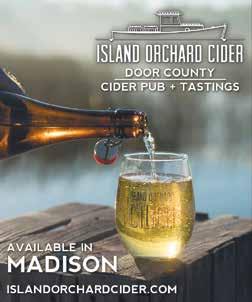
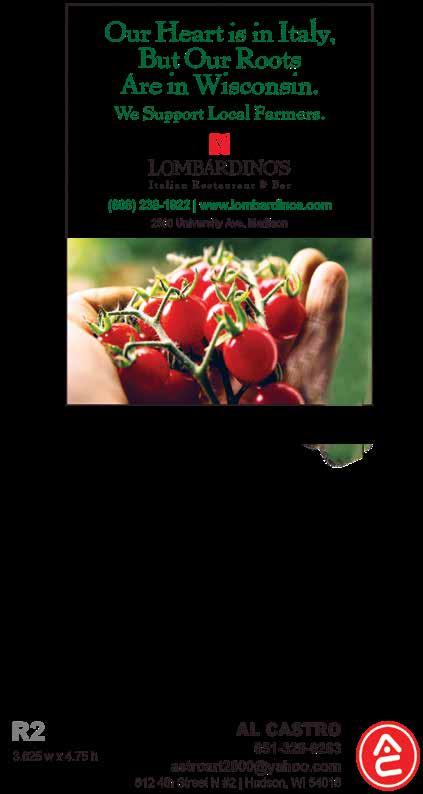

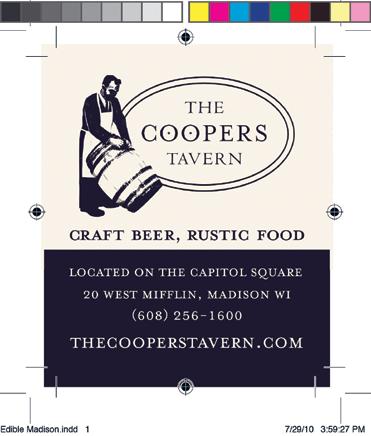
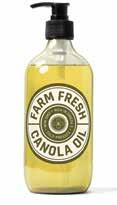





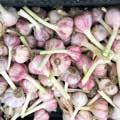

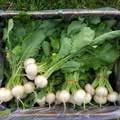
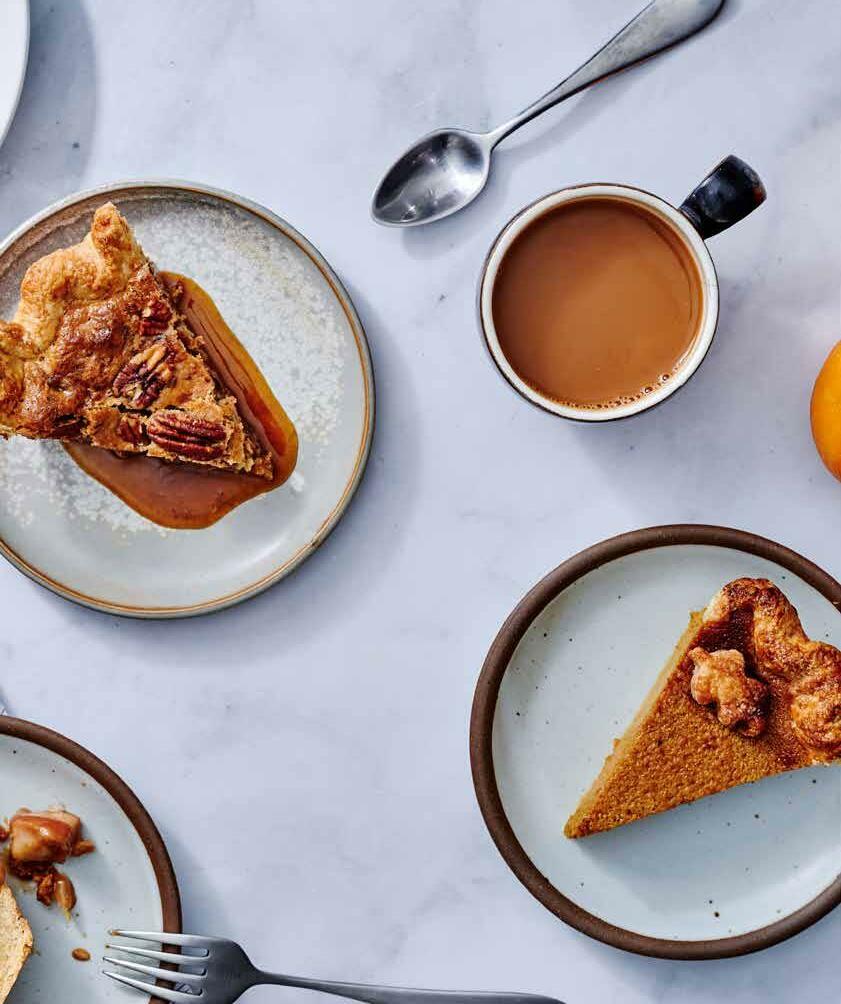
I can’t lie, I sigh Cry, even think I will die For good breakfast pie.
—Fabu Phillis Carter, Former Wisconsin Poet LaureatePhoto by Sunny Frantz.

